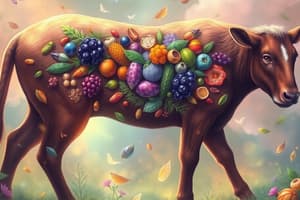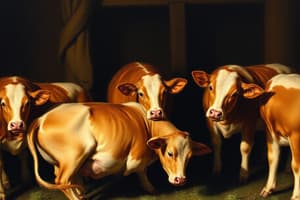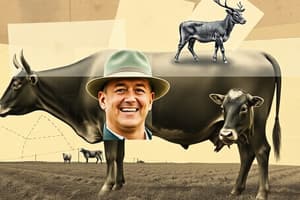Podcast
Questions and Answers
Animal nutrition primarily focuses on the study of how animals synthesize nutrients from sunlight and air.
Animal nutrition primarily focuses on the study of how animals synthesize nutrients from sunlight and air.
False (B)
Providing proper animal nutrition is essential for good health and increased productivity, but has little impact on feed efficiency or overall well-being.
Providing proper animal nutrition is essential for good health and increased productivity, but has little impact on feed efficiency or overall well-being.
False (B)
Nutrients are substances that enable animals to perform life processes and are primarily acquired through air and sunlight.
Nutrients are substances that enable animals to perform life processes and are primarily acquired through air and sunlight.
False (B)
Farm animals can only obtain nutrients from plant sources like grasses, grains, and legumes.
Farm animals can only obtain nutrients from plant sources like grasses, grains, and legumes.
While water is important, animals can survive longer without it compared to food, as water only comprises a small fraction of their body weight.
While water is important, animals can survive longer without it compared to food, as water only comprises a small fraction of their body weight.
According to Lawes and Gilbert's 1859 analysis, the ratio of water to protein to ash in a fat-free animal body is precisely 20:5:1.
According to Lawes and Gilbert's 1859 analysis, the ratio of water to protein to ash in a fat-free animal body is precisely 20:5:1.
The protein to ash ratio in a moisture-free and fat-free animal body is approximately 80:20.
The protein to ash ratio in a moisture-free and fat-free animal body is approximately 80:20.
Water solely functions to remove waste from the animal's body.
Water solely functions to remove waste from the animal's body.
Carbohydrates, with the chemical formula $C_6H_{12}O_6$, should ideally constitute at least 75% of an animal's diet, primarily serving as energy-yielding nutrients.
Carbohydrates, with the chemical formula $C_6H_{12}O_6$, should ideally constitute at least 75% of an animal's diet, primarily serving as energy-yielding nutrients.
A 10-month-old calf is expected to have a higher percentage of body water content compared to a newborn calf.
A 10-month-old calf is expected to have a higher percentage of body water content compared to a newborn calf.
Animal teeth enamel contains a significantly higher percentage of water compared to blood plasma.
Animal teeth enamel contains a significantly higher percentage of water compared to blood plasma.
Energy deficiency in grazing animals only arises due to the lack of minerals in their diet.
Energy deficiency in grazing animals only arises due to the lack of minerals in their diet.
Protein, alongside inorganic elements, contributes to the structural components of an animal, with muscles primarily composed of approximately 75-80% protein on a dry matter basis.
Protein, alongside inorganic elements, contributes to the structural components of an animal, with muscles primarily composed of approximately 75-80% protein on a dry matter basis.
The fat content in an animal's body typically decreases linearly with age due to increased metabolic activity.
The fat content in an animal's body typically decreases linearly with age due to increased metabolic activity.
Carbohydrates constitute approximately 10% of the total animal body mass, primarily in the form of cellulose.
Carbohydrates constitute approximately 10% of the total animal body mass, primarily in the form of cellulose.
While calcium and phosphorus are abundant in teeth and bones, sodium, potassium, and chlorine are primarily associated with structural proteins.
While calcium and phosphorus are abundant in teeth and bones, sodium, potassium, and chlorine are primarily associated with structural proteins.
Forage with excessive water content can enhance energy intake in animals.
Forage with excessive water content can enhance energy intake in animals.
Energy deficiencies in animals can lead to a shortened lactation period in milking animals, resulting in a decline in milk production.
Energy deficiencies in animals can lead to a shortened lactation period in milking animals, resulting in a decline in milk production.
Proteins are organic compounds composed of amino acids and contain carbon, hydrogen, oxygen, and potassium.
Proteins are organic compounds composed of amino acids and contain carbon, hydrogen, oxygen, and potassium.
Animals require protein solely for building new cells and tissues, such as muscles.
Animals require protein solely for building new cells and tissues, such as muscles.
Protein deficiencies are typically more severe than energy deficiencies in livestock.
Protein deficiencies are typically more severe than energy deficiencies in livestock.
Fats contain 3.25 times more energy than carbohydrates.
Fats contain 3.25 times more energy than carbohydrates.
Excess energy from proteins is stored as fat in animals.
Excess energy from proteins is stored as fat in animals.
Vitamins are inorganic compounds needed in large quantities for optimal animal health.
Vitamins are inorganic compounds needed in large quantities for optimal animal health.
Vitamin deficiencies can lead to issues with the utilization of proteins, fats, and carbohydrates, as well as impaired blood clotting and bone formation.
Vitamin deficiencies can lead to issues with the utilization of proteins, fats, and carbohydrates, as well as impaired blood clotting and bone formation.
Minerals are classified into micro and nano minerals based on their quantities needed by the animal body.
Minerals are classified into micro and nano minerals based on their quantities needed by the animal body.
Flashcards
Animal Nutrition
Animal Nutrition
The science and practice of feeding animals, including how they ingest, digest, absorb, and use nutrients.
Benefits of Proper Animal Nutrition
Benefits of Proper Animal Nutrition
Good health, increased productivity and feed efficiency, and overall well-being.
Nutrient
Nutrient
A substance necessary for an organism to live and grow, obtained through feed and water.
Sources of Nutrients for Farm Animals
Sources of Nutrients for Farm Animals
Signup and view all the flashcards
Six Essential Nutrients
Six Essential Nutrients
Signup and view all the flashcards
Functions of Water in Animals
Functions of Water in Animals
Signup and view all the flashcards
Carbohydrates
Carbohydrates
Signup and view all the flashcards
Causes of Energy Deficiency
Causes of Energy Deficiency
Signup and view all the flashcards
Energy Deficiency Results
Energy Deficiency Results
Signup and view all the flashcards
Proteins
Proteins
Signup and view all the flashcards
Protein Deficiency
Protein Deficiency
Signup and view all the flashcards
Fats & Lipids
Fats & Lipids
Signup and view all the flashcards
Vitamins
Vitamins
Signup and view all the flashcards
Vitamin Roles
Vitamin Roles
Signup and view all the flashcards
Vitamin Deficiency
Vitamin Deficiency
Signup and view all the flashcards
Minerals
Minerals
Signup and view all the flashcards
Protein Sources
Protein Sources
Signup and view all the flashcards
Fats & Lipids Sources
Fats & Lipids Sources
Signup and view all the flashcards
Energy Feeds Examples
Energy Feeds Examples
Signup and view all the flashcards
Mineral Licks
Mineral Licks
Signup and view all the flashcards
Protein Sources in Feed
Protein Sources in Feed
Signup and view all the flashcards
Water and Fat Relationship
Water and Fat Relationship
Signup and view all the flashcards
Protein to Ash Ratio
Protein to Ash Ratio
Signup and view all the flashcards
Water Content with Age
Water Content with Age
Signup and view all the flashcards
Protein's Role
Protein's Role
Signup and view all the flashcards
Body Fat
Body Fat
Signup and view all the flashcards
Study Notes
- Animal nutrition and feeding is the study of nutrients animals require to live and grow.
Nutrition
- Nutrition is a branch of biology.
- Nutrition is the science and practice of feeding animals.
- Nutrition is the process by which animals ingest, digest, absorb and use nutrients in feed for maintenance, growth, work, and reproduction.
- Proper animal nutrition leads to good health, increased productivity, increased feed efficiency and well-being.
Nutrients
- A nutrient is a substance that is necessary for an organism to live and grow.
- Nutrients make it possible for animals to carry out life processes.
- Nutrients are typically provided to animals through feed and water.
- Farm animals primarily get their nutrients from plants, plant products and by-products, and animal products.
- Plants like grasses, forage crops, and legumes provide farm animals with nutrients.
- Plant products and by-products like grains (corn, rice, wheat), rice bran, wheat middlings, copra meal and soybean meal.
- Animals products like bone meal, fish meal, meat meal, shrimp meal, and milk provide farm animals with nutrients.
Essential Nutrients
- The six essential nutrients are water, carbohydrates, fats, proteins, minerals, and vitamins.
Water
- Water is necessary for an animal to live; they can live longer without food.
- Water is the component of nearly all living things.
- Water makes up 50-75% of an animal's body weight.
- Water transports nutrients, aids in digestion, removes wastes, helps maintain body temperature and is required for milk production.
Carbohydrates
- Carbohydrates are energy-producing nutrients with the formula C6H12O6, also known as glucose.
- An animal's diet should consist of at least 75% carbohydrates.
- Animals need energy for metabolic activity, physical work, meat, egg and milk production.
- Simple sugars, like glucose, fructose and galactose are monosaccharides.
- Maltose, sucrose and lactose are disaccharides.
- Starch, cellulose, hemicellulose and lignin are polysaccharides.
- Carbohydrates can be sourced from pasture grasses, plant products and by-products (root crops, fruits, seeds, grains, rice bran, wheat bran).
Energy Deficiency
- Energy deficiency, including a lack of carbohydrates, is the most common nutritional deficiency that limits the performance of grazing animals.
- Inadequate feed can result from overgrazing, drought, poor quality/digestibility feed, or feed cost.
- Forage may have too much water, thereby limiting energy intake.
- Energy deficiencies in animals result in retarded growth, delayed puberty, shortened lactation, decreased milk production and marked loss of weight.
- Prolonged anestrus periods and weak or undersized offspring may also result from energy deficiencies.
Protein
- Proteins are organic compounds made of amino acids containing carbon, hydrogen, oxygen and nitrogen.
- Animals require protein for building new cells and tissues (including muscles), milk, wool, hair and feather production; body maintenance and the production of enzymes and hormones.
- Protein can be sourced from pasture legumes.
- Animals products like fish meal, bone meal, milk, meat meal, and blood meal are sources of protein.
Protein Deficiency
- Protein deficiency often accompanies energy deficiencies but is, typically, not as severe.
- Reduced appetite, lowered feed intake, lack of muscle development, prolonged maturity time, loss of weight and decreased milk production are all effects of protein deficiency.
Fats & Lipids
- Fats and lipids are made of fatty acids and glycerol, and contain carbon, hydrogen and oxygen.
- Fats have 2.25 times more energy than carbohydrates.
- Fats supply and store energy where excess carbohydrates are stored as fat.
- Fats are stored under the skin without the muscle tissues and under the abdominal activity.
- Fats can be sourced from oilseed meals (copra, canola, linseed), vegetable oils, tallow and lard.
Vitamins
- Vitamins are organic compounds needed in small quantities for healthy growth and development.
- Fat-soluble vitamins include vitamins A, D, E, and K.
- Water-soluble vitamins include vitamins B and C.
- Vitamins are essential for the proper utilization of proteins, fats and carbs, the clotting of blood and the formation of bone.
- They also play a role in reproduction and lactation and they can help with the prevention of certain nervous disorders.
Vitamin Deficiency
- Vitamin deficiency can result in retarded growth, poor reproduction, hemorrhaging, diarrhea, night blindness, a rough coat and muscular problems.
- You can source vitamins from green pasture grasses and legumes, legume hays, silage, cereal grains, oil seeds, sunlight, and injectable/packet vitamins.
Minerals
- Minerals promote healthy growth and development.
- There are 16 essential minerals divided into macro and micro minerals, all with a specific role in the animal's body.
- Calcium and phosphorus promote strong teeth and bones and strong eggshells, and they also prevent milk fever in dairy cattle.
- Mineral sources include green pasture grasses and forages, legumes (including pasture legumes), cereal grains (corn, rice, sorghum), mineral licks (salt licks and blocks) and fish, bone and shrimp meal.
Composition of the Animal Body
- J.B. Lawes and J.H. Gilbert analyzed the bodies of farm animals and published it in 1859.
- The level of water and fat varies inversely.
- The composition of fat-free body water, protein and ash is 19:5:1 (74-76%: 20-22%: 3-5%).
- In fat and moisture-free bodies, protein and ash is 80:20.
- Body composition of a moisture and fat-free body is constant.
Animal Body
- Water content decreases as age increases.
- A cattle embryo contains 95% water, a newborn calf contains 75-80% water, a 5-month old calf contains 66-72% water and a mature animal contains 50-70% water.
- Distribution of water within the body is not uniform.
- Blood plasma contains approximately 90-92% water.
- The heart, kidneys and lungs contain approximately 80% water.
- Muscles contain approximately 75% water.
- Bones contain approximately 45% water.
- Teeth enamel contains only approximately 5% water.
- Water content depends on an animal's nutritional status.
- Protein and some inorganic elements affect the structure of an animal's body.
- Protein is a major constituent of dry matter in muscles and other body organs.
- Muscles contain almost 75-80% protein.
- Protein is also present in hair, nails, feathers, hooves, skin, wool, tendons and bones.
- Fat tends to be the most variable of all body components and increases with age.
- Fat is usually found in adipose tissues which are found under the skin, around the kidney, intestines, and other body organs.
- Carbohydrates are only about 1% of the total animal body.
- Carbohydrates are constantly formed and broken down and mostly exist as glucose or glycogen in the muscles and liver.
- Calcium and phosphorus are minerals that appear in in the largest amounts in the body and almost entirely exist in teeth and bones.
- Phosphorus is also present in association with protein, fats and other inorganic salts.
- Calcium and phosphorus make up for 70% of body ash.
- Sodium, potassium and chloride are present in the inorganic form in various fluids.
- Other minerals form components of tissues, fluids and enzymes.
Studying That Suits You
Use AI to generate personalized quizzes and flashcards to suit your learning preferences.




